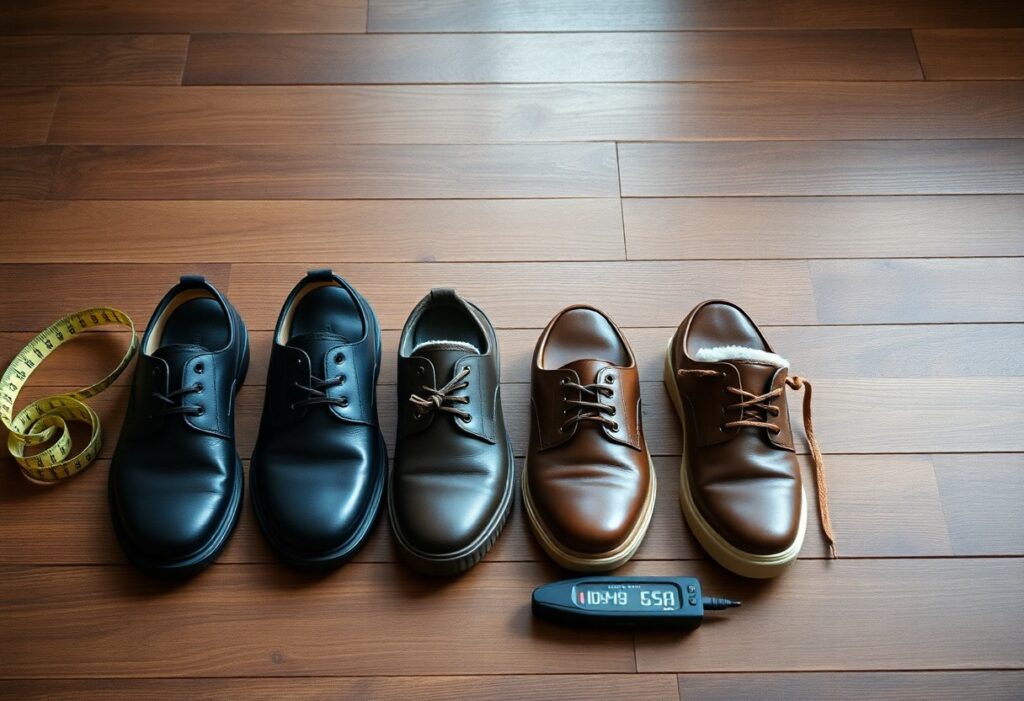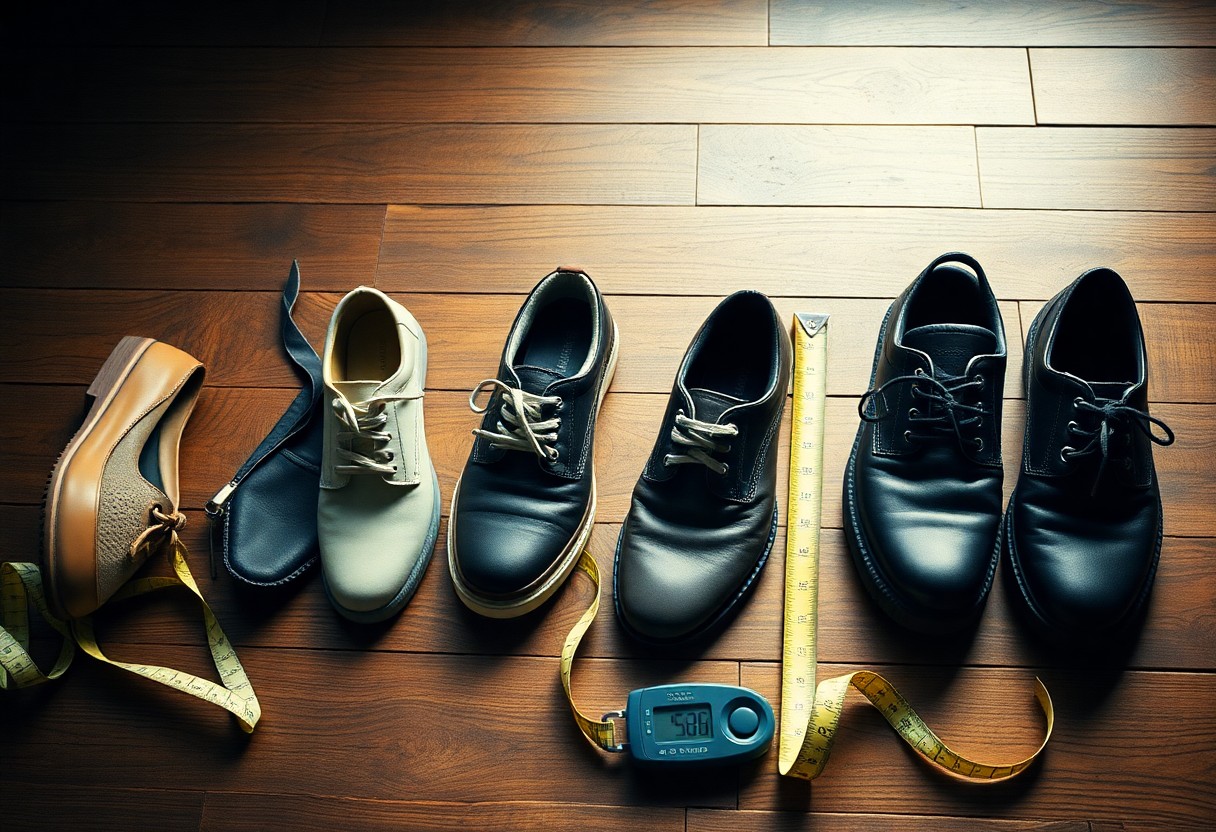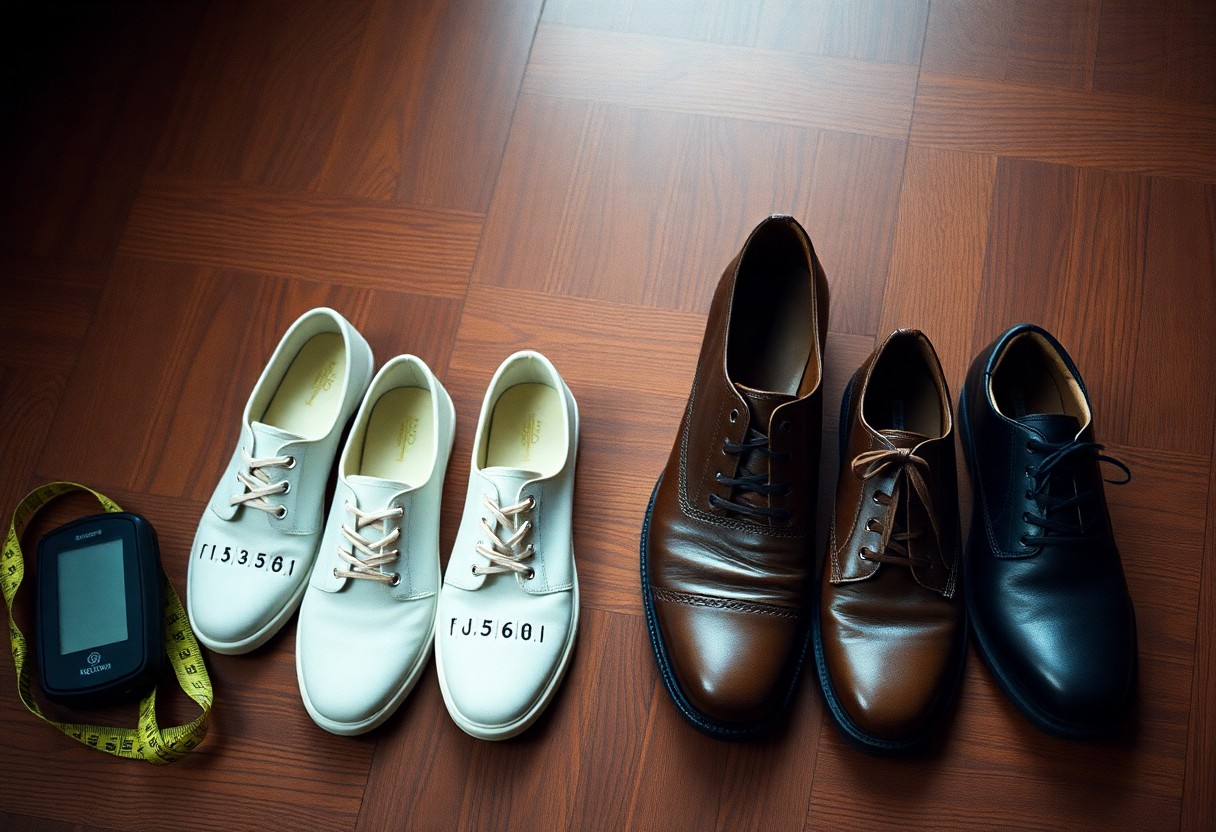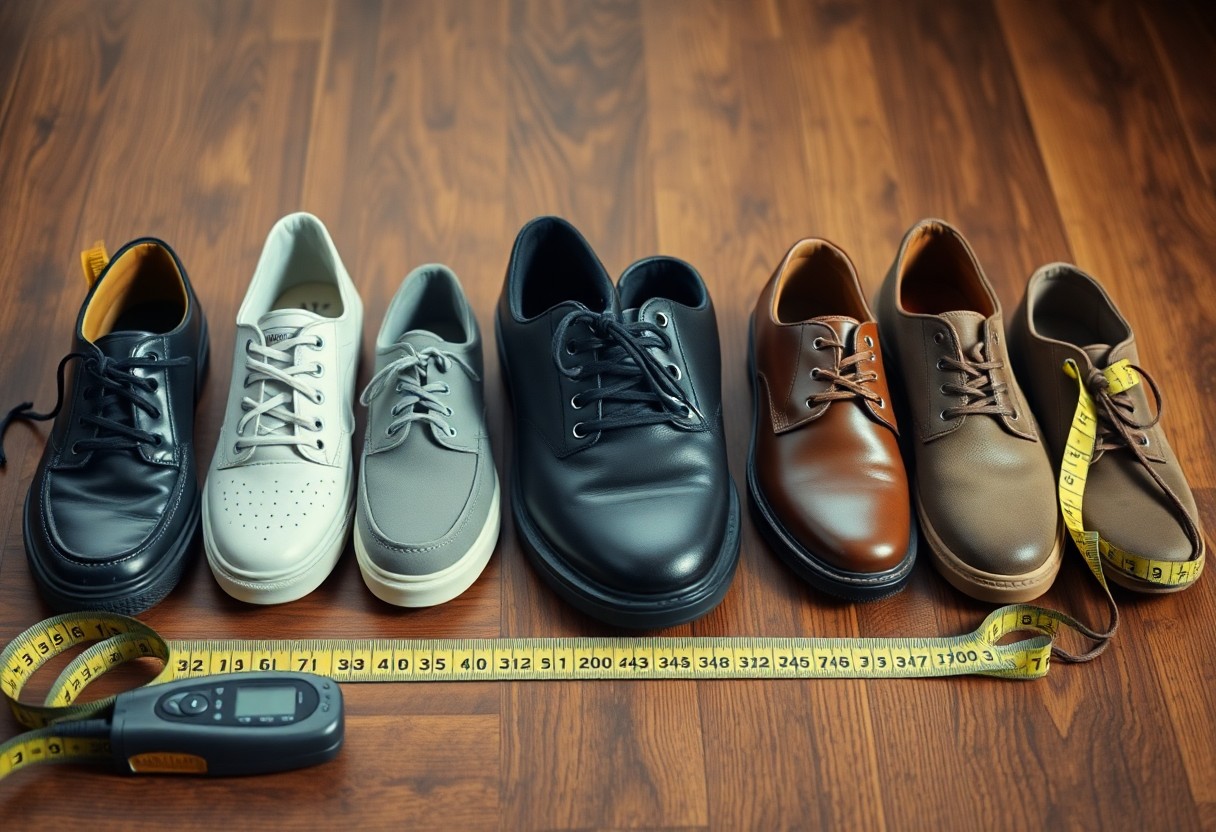
Recognizing the significance of selecting shoes with the appropriate width is crucial for protecting your overall foot health and preventing discomfort. Wearing shoes that fit properly can greatly minimize foot pain and reduce the risk of various health issues. When you are out shopping for footwear, it is vital to pay attention to both the length and width of the shoes to achieve a flawless fit. Opting for shoes with the correct width not only enhances your stability and blood flow but also lowers the likelihood of developing blisters and other foot-related problems. To discover your ideal shoe width, measure the widest part of your foot and consult standardized width charts. Many shoppers often mistakenly focus only on length, overlooking the fact that adequate width is equally essential for everyday comfort and foot health.
Master the Art of Measuring Your Feet for Optimal Shoe Fit
The best approach to determine your shoe width is to measure your feet at the end of the day when they are most likely to be swollen. Your foot width can change by as much as half an inch during the day, making evening measurements the most accurate for a proper fit. To do this, stand on a sheet of paper and trace around your foot, ensuring that you capture the most precise outline possible. This straightforward method can assist you in finding shoes that not only fit comfortably but also provide the necessary support your feet deserve. By taking the time to measure your feet correctly, you are taking the first step towards achieving long-lasting foot comfort.
Essential Techniques for Accurate Foot Width Measurement
Alongside using a standard ruler, consider employing a Brannock Device, a specialized instrument commonly found in most shoe stores that accurately gauges foot size. This device enables you to measure the widest part of your foot, typically located across the ball area. To ensure the best results, it’s essential to measure both feet while standing, as one foot may often be slightly larger than the other. By doing so, you can select shoes that accommodate the larger foot, effectively avoiding discomfort during wear and enhancing your overall footwear experience.
How to Avoid Common Pitfalls When Choosing Shoe Width
A prevalent mistake when selecting shoe width is underestimating the importance of accurate width measurements. Many individuals focus solely on the length, which can lead to significant discomfort and a range of potential foot problems. Other common errors include measuring feet while seated and incorrectly assuming that your foot width remains unchanged over time. It’s crucial to understand that wearing shoes that are too narrow can result in serious foot complications such as bunions, corns, and hammertoes. Foot dimensions can shift due to factors like weight gain, pregnancy, or aging, which is why it is advisable to measure your feet annually. Selecting the correct width can help ward off blisters, calluses, and persistent foot pain.

Comprehending Shoe Width Systems and Standards for the Best Fit
Becoming familiar with the various shoe width systems is vital for ensuring comfort and optimal foot health. Different brands and countries utilize distinct measurement standards, and understanding these systems can guide you in selecting shoes that fit well and prevent foot problems. By knowing how width is classified, you can make educated choices when selecting footwear tailored to your specific needs.
Decoding Letter-Based Width Scales for the Perfect Shoe Fit
When perusing shoes, you’ll often notice widths labeled from AA to EE. For women, a standard medium width is B, whereas for men, it is D. Narrow widths are categorized from AA to B, while wide widths extend from D to EE. This letter-based classification is designed to help you identify the most suitable fit based on your foot shape, ensuring that your shoes feel comfortable and provide essential support throughout the day.
Understanding International Width Measurement Standards and Their Impact
When shopping globally, you may encounter various measurement systems that can complicate your shoe selection process. For example, European sizes are based on millimeters, and UK sizes follow their own width standards. Your US shoe size may differ from international measurements by one to two width sizes. Therefore, it’s essential to always check the brand’s size chart before buying shoes from overseas. Japanese shoes tend to be narrower, while European brands frequently feature a wider toe box. To ensure the best fit, measuring your feet in millimeters serves as the most accurate reference for international purchases.

How Shoe Construction Influences Fit and Comfort Levels
To make informed footwear choices, it is crucial to understand how shoes are constructed. The design and build of a shoe greatly affect its fit and feel on your feet. Your comfort is significantly influenced by how the upper part of the shoe connects to the sole and the flexibility of the materials around the widest part of your foot. By choosing shoes with thoughtful construction, you can enhance your overall comfort and ensure adequate support for your feet, which is essential for everyday wear.
The Advantages of Natural Materials in Footwear
Shoes crafted from genuine leather are known for their exceptional breathability and flexibility. Leather has a remarkable capacity to stretch and mold to your foot shape over time, resulting in a customized fit that many wearers appreciate. Studies have shown that leather shoes can expand by up to 30% of their original width, making them an excellent option for individuals with varying foot widths who prioritize comfort and adaptability.
Durability and Consistency Offered by Synthetic Shoe Materials
Synthetic materials available on the market provide consistent width measurements and remarkable durability. These modern materials safeguard your feet while also offering water resistance and enhanced breathability. Many synthetic shoes now incorporate mesh panels that boost airflow and flexibility. Furthermore, advancements in synthetic materials have introduced comfort features such as memory foam and gel inserts. Consequently, shoes can now combine stable width measurements with targeted cushioning, delivering outstanding support during wear. Recent research indicates that synthetic materials can maintain their shape up to 40% longer than traditional materials, ensuring that your shoes preserve their appropriate width throughout their lifespan.

Recognizing Signs of Proper Shoe Width for Maximum Comfort
Unlike length, the correct shoe width can be determined by how your feet feel and function in them. Your shoes should allow your toes to spread freely while walking, with approximately half an inch of space at the widest part. Research shows that 70% of people wear shoes that do not fit properly in width, resulting in numerous foot-related issues. By identifying the signs of proper width, you can make better footwear choices that enhance your comfort and foot health.
Key Indicators of Comfort from Correct Shoe Width
Here are some important signs that indicate your shoes fit correctly in terms of width: your toes should be able to wiggle freely, the ball of your foot should align perfectly with the widest part of the shoe, and you should not experience any pinching on the sides. A well-fitted shoe allows your feet to expand naturally throughout the day, as it is normal for feet to swell by up to 8% by the end of the day.
Warning Signs That Suggest Incorrect Shoe Width
While wearing shoes, it is important to be mindful of warning signs such as numbness or tingling in your toes, blisters on the sides of your feet, and pressure marks on your skin after removing your shoes. These symptoms indicate that your shoes may be either too narrow or too wide for your feet. Proper width is vital for maintaining foot health, as research indicates that ill-fitting shoes can lead to long-term foot issues. You should feel no pressure points when standing or walking; if you experience pain, redness, or if your foot spills over the edges of the shoe, it’s time to explore different width options.
Understanding Width Variations Across Different Brands
Numerous shoe manufacturers provide a range of width options, from AA (super narrow) to 4E (extra wide). It’s noteworthy that foot width can vary throughout the day, and studies reveal that up to 70% of individuals have different widths between their left and right foot. Grasping these variations will empower you to select shoes that accommodate your unique foot shape and prevent discomfort and potential foot complications.
The Influence of Brand Differences on Shoe Width Measurements
When evaluating various brands, you might observe substantial differences in width measurements. A medium width in one brand could feel narrow in another. European brands tend to run narrower than American brands, while athletic footwear companies often offer the most extensive width options available. It is always advisable to try on shoes before making a purchase, as sizes can fluctuate significantly across manufacturers.
The Role of Shoe Style in Width Fitting
The style of the shoe plays a significant role in how width fits your foot. Athletic footwear generally provides greater flexibility in width compared to dress shoes, while sandals are designed to accommodate a more natural width. Your foot width requirements may vary based on the shoe’s intended use and the activities you plan to partake in. Further analysis indicates that certain styles necessitate specific width considerations. For example, high heels demand a secure fit to prevent slipping, while work boots may need extra width to comfortably fit thicker socks. Running shoes should provide approximately half an inch of space between your longest toe and the shoe’s tip for optimal comfort and performance.
Recognizing Special Width Requirements for Unique Foot Needs
While standard sizing options are widely available, some individuals may require specific width accommodations. Conditions such as bunions, flat feet, or swollen feet may necessitate wider shoes. Furthermore, your foot width can change throughout the day, with studies indicating a possible 4% increase in foot volume by evening. Recognizing these variations is essential for selecting shoes that remain comfortable throughout your daily activities.
Foot Conditions That Necessitate Special Width Accommodations
Special width needs frequently arise from medical conditions. For individuals with diabetes, arthritis, or edema, it’s critical to have shoes with extra width allowance to ensure proper circulation. Healthcare professionals may suggest specific width measurements to prevent complications associated with these health issues. Research indicates that 75% of individuals with foot conditions benefit from specialized width fittings, underscoring the importance of appropriate footwear in maintaining foot health.
Activity-Specific Width Requirements for Peak Performance
An active lifestyle calls for different shoe widths tailored for various activities. For example, your running shoes may need more width compared to your casual footwear, while hiking boots require extra space to accommodate thicker socks. Athletes often benefit from shoes that are half a size to a full size wider for high-impact activities, allowing necessary foot expansion during intense performance. When considering activity-specific fitting, it's essential to factor in your foot’s natural movement patterns. During running, your feet can expand up to half a size wider. For sports that involve lateral movements, such as tennis or basketball, adequate width is crucial to avoid foot strain and potential injuries. Your footwear choices should align with your activity level and unique foot characteristics for the best results.
Discovering Your Ideal Shoe Width for Long-Lasting Comfort
The secret to finding your perfect shoe width lies in mastering proper measurement techniques and understanding your available width options. By measuring your feet at their widest points, identifying your width category (ranging from A to E), and selecting shoes that correspond with your measurements, you can ensure enduring comfort. Your shoes should fit snugly without pinching or sliding, allowing your toes the freedom to move comfortably. By prioritizing the right width and choosing materials that cater to your feet, you can enjoy the benefits of well-fitting footwear that supports your daily activities and lifestyle.
Your Most Common Questions About Shoe Width Answered
Q: What is the best method to measure my foot width at home?
A: To accurately measure your foot width at home, place your foot on a blank sheet of paper and trace its outline. Measure the widest part, typically at the ball of your foot, using a ruler. It’s best to take measurements in the afternoon when your feet are at their largest. Don’t forget to measure both feet, as one may be wider than the other. Use these measurements to compare with shoe width charts provided by manufacturers to ensure a proper fit.
Q: What are the typical width measurements for shoes?
A: Shoe widths generally utilize letter codes ranging from A to E. For women, the standard medium width is B, while for men, it’s D. Narrow widths are represented by A and AA, while C and D indicate medium-wide for women. E and EE signify wide widths. Remember that each brand may exhibit slight variations in their width measurements, so it’s wise to consult their specific size charts before making a purchase to ensure a proper fit.
Q: How can I determine if my current shoes are the wrong width?
A: To identify if your current shoes are improperly fitted, look for indicators such as red marks on the sides of your feet, numbness in your toes, blisters on your heels or sides, and shoes that slip off while walking. Your toes should have ample space to wiggle freely, and the ball of your foot should fit snugly at the widest part of the shoe. If you feel pressure on the sides, it’s time to consider a wider shoe. Conversely, if your foot moves side-to-side, you may need a narrower width for better support.
The Article How to choose the right shoe width tips for a comfortable fit appeared first on My Shoes Finder
The Article Choosing the Right Shoe Width for Ultimate Comfort Was Found On https://limitsofstrategy.com

